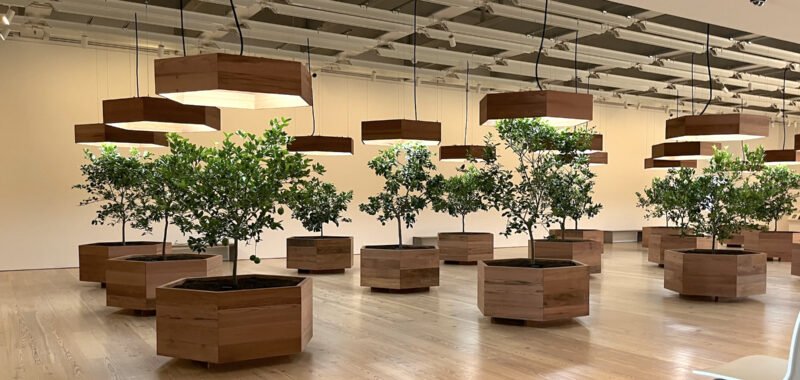As the elevator doors open out to the Whitney Museum’s top floor, 18 living citrus trees come into view. The installation, a reprisal of Helen Mayer Harrison and Newton Harrison’s project Survival Piece #5: Portable Orchard (1972/2024), appears bright and airy but also regimented. The trees — growing varieties of lemons and limes, oranges and grapefruits — have been organized into a three-by-six grid, each tree situated inside a planter made from reclaimed redwood. With their clean geometry and overhead grow lights, the planters resemble indoor gardening kits purchased at a big box store. It’s an aesthetic that’s at once visually harmonious and conceptually discordant, a calm and orderly response to the dystopian possibilities of climate upheaval.
Prompted by the then-nascent environmental movement, the Harrisons’ early 1970s Survival Pieces were gallery installations that took the form of harvestable food ecosystems such as a hog pasture and a fish farm. In their controversial incorporation of living beings, the works were forerunners to today’s BioArt. Refreshingly, the Survival Pieces’ tones and content differ from most BioArt’s sci-fi atmosphere, as well as from contemporary doomsday prepping’s dog-eat-dog mindset. Instead, the husband-and-wife artistic duo were cooperative-minded from the start, collaborating not just with one another but also, as their practice developed, with scientists, urban planners, and activists. This method of working drew on loosened, post-1960s conceptions of what art could be and do and helped create the template for a strain of environmental art — from Agnes Denes’s “Wheatfield – A Confrontation” (1982) to Mel Chin’s “Revival Field” (1991–present) — that imagines quixotic alternatives to local ecological concerns.

In Portable Orchard, this approach feels inadequate to the magnitude of the crisis, the kind of small-scale solution to a large-scale problem that contemporary political theorists Nick Srnicek and Alex Williams call “folk politics.” The Whitney exhibition’s didactics cite two seminal environmentalist texts, Rachel Carson’s 1962 Silent Spring and Stuart Brand’s Whole Earth Catalog (1968–72), as key intellectual context for the Survival Pieces. Yet Stanford University researchers Paul and Anne Ehrlich’s alarmist best-selling 1968 book, The Population Bomb, which predicted mass global starvation due to overpopulation as soon as the 1970s and ’80s, also seems essential to a contemporaneous art project addressing potential food shortages. While the Ehrlichs’ fear-mongering proved overblown, Portable Orchard’s orderly beauty nonetheless presents a manicured vision of what survivalism might entail.
That vision was an exciting artistic departure for its time — and remains uplifting today. I visited Portable Orchard the week it opened, and though its fruits hadn’t yet ripened the installation still looked and smelled lovely. But the tickle of inspiration I felt in the gallery, the brief recognition that the present order of things could be different in good and bad ways, doesn’t amount to much without the policy planning needed to bring about positive change. In the 1970s, when public and scientific knowledge about anthropogenic climate change were emergent, environmentalist consciousness raising — through art and other means — helped improve both awareness and policy. Today, when our species knows too much and does too little, Portable Orchard feels equal parts hopeful and compensatory, an art historical case study in how far we’ve come on the climate, and how far we haven’t.




Survival Piece #5: Portable Orchard continues at the Whitney Museum of American Art (99 Gansevoort Street, Meatpacking District, Manhattan) through January 5, 2025. The exhibition was organized by Kim Conaty, Nancy and Steve Crown Family Chief Curator, with Roxanne Smith, Senior Curatorial Assistant.

